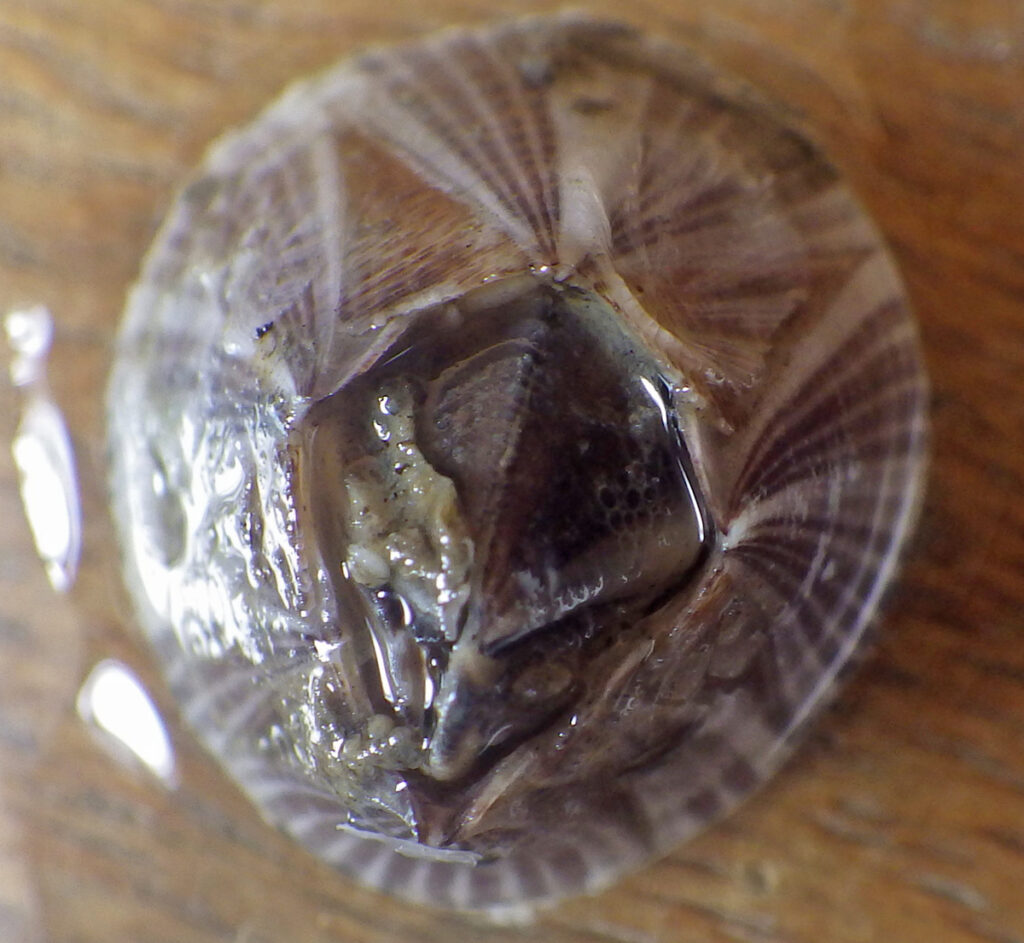
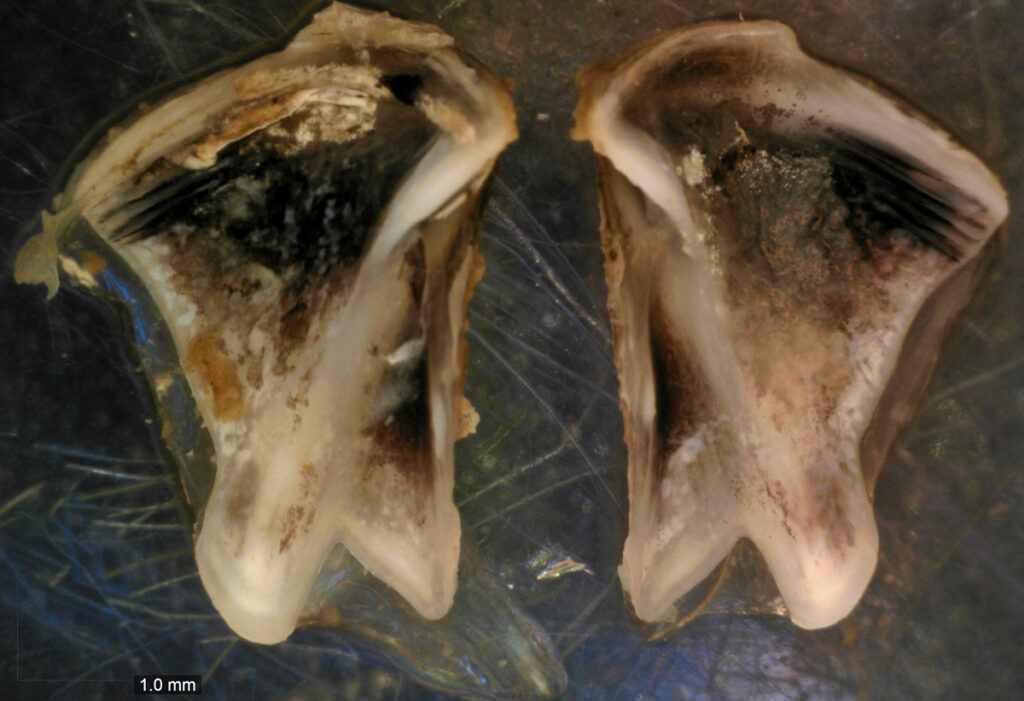
Striped barnacle
Amphibalanus amphitrite
Also known as: n.a.
What does it look like?
This barnacle which can become up to 3 cm broad has purple stripes running from base to top on all sides. It usually has a regular circular to slightly oval base.
Distinguishing features
Barnacles with clear purple colour patterns found in Irish waters are always non-native, with Amphibalanus amphitrite being one of the most common species found in western Europe. To distinguish this species from similar looking barnacles, the feature to look for is the form of two of the four plates which are positioned in the centre of the specimen (see figure). These plates, functioning as “doors”, can be opened by the barnacle when it wants to feed. Typical for A. amphitrite are the two extensions at the bottom of the plates illustrated, which are relatively broad and similar in length to each other.
Confusion with similar species
Two Megabalanus species, which are also non-native in Europe may resemble Amphibalanus amphitrite as they also have purple colouration. Where A. amphitrite specimens tend to have a regular pattern with distinct purple stripes in groups of about 4 to 5, Megabalanus specimens usually have a more continuous and irregular purple colouration. In addition the “door plates” of these species are distinctly different.
Balanus tigronus has strongly ribbed plates and a very irregularly formed basis in comparison to A. amphitrite. B. tigronus specimens can also have distinct purple stripes, similar to those of A. amphitrite, but the purplish pattern can also be irregular.
What is its origin?
Indo-West Pacific
Habitat
Amphibalanus amphitrite can be found in the intertidal to subtidal in usually somewhat sheltered marine waters. It is common for example on the oyster trestles along the coast of France but has also repeatedly been found in ship hull fouling communities. A. amphitrite is usually found in warmer waters than those experienced around the coast of Ireland.
Presence in Ireland
Amphibalanus amphitrite is not yet established in Ireland. However, it has been recorded in the south of Britain and along the Dutch coastline. It is therefore possible that it may be able to settle and reproduce during warm summers in Irish waters.
Behaviour and Spread
As Amphibalanus amphitrite barnacles, depending on their size, can produce 1,000 to 10,000 eggs per animal, they may expand their populations rapidly when the environmental conditions are acceptable for reproduction. It is assumed that this tropical species need water temperatures above 15 ° Celsius for successful reproduction.
Potential nuisance for aquaculture
Amphibalanus amphitrite is a large barnacle species when compared to barnacles that are currently established in Ireland. Its presence on oyster trestles in France indicates that it may also settle on such trestles along the coast of Ireland, possibly causing a nuisance for the shellfish industry as a fouling species. As A. amphitrite can survive in both subtidal and intertidal habitats it may be relatively hard to get rid of when growing on mussels or oysters. Therefore, A. amphitrite is more resilient than the native barnacle species Balanus crenatus which is only found in the subtidal and will die and fall of shellfish when placed in the intertidal for an extended period.
Key Management Actions
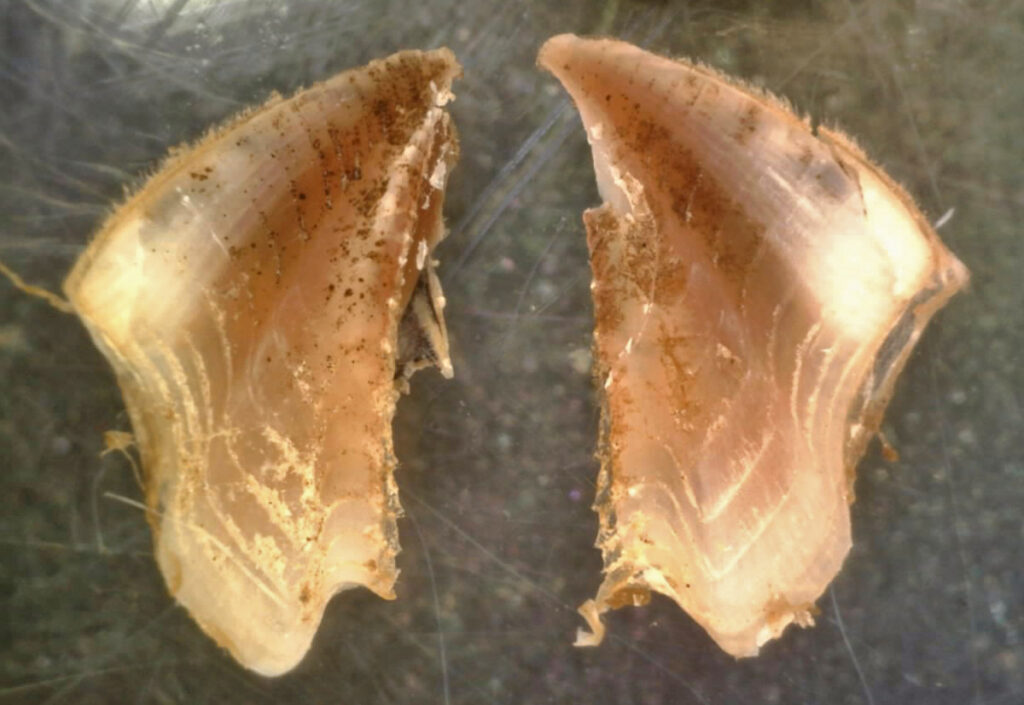
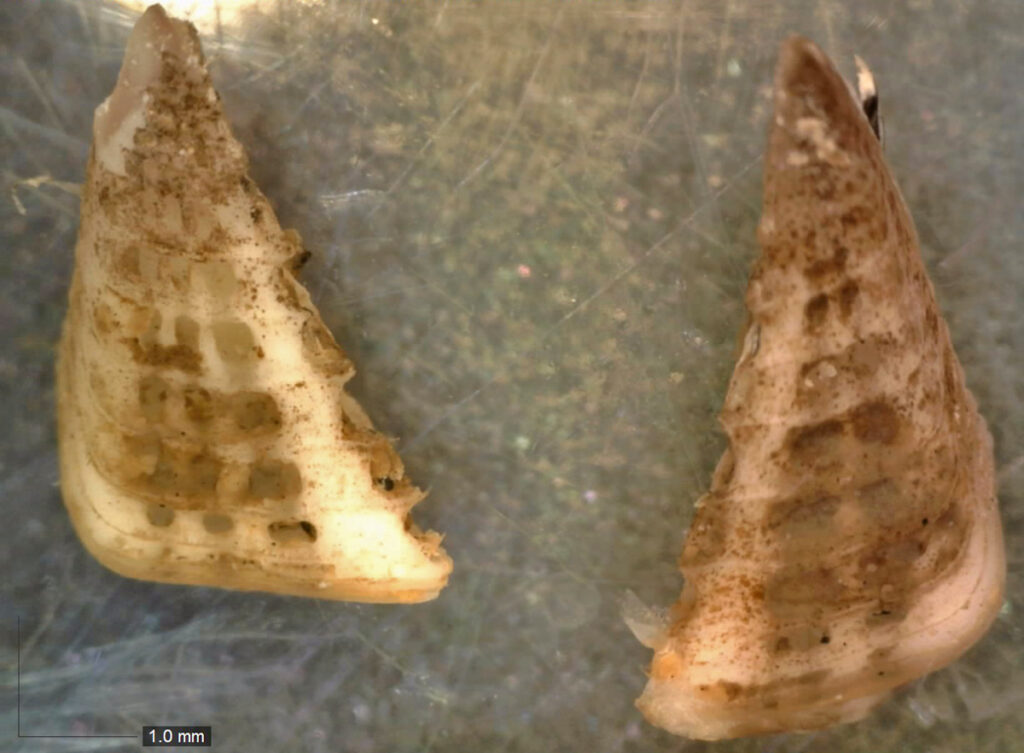
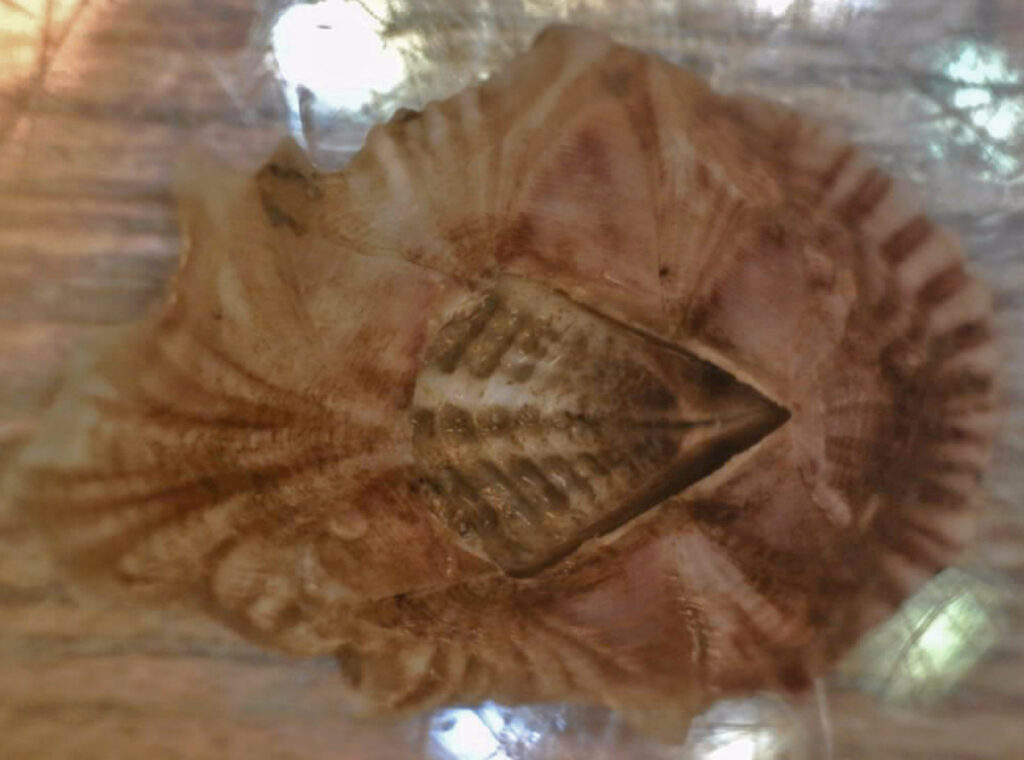
Triangle barnacle
Balanus tigronus
Also known as: n.a.
What does it look like?
This barnacle which can become up to 2.5 cm broad has a striped to irregular dotted purplish pattern. It has distinct ribs and ridges on its plates and has an irregularly formed oval base.
Distinguishing features
Barnacles with clear purple colour patterns found in Irish waters, are always a non-native barnacle species. The best features to distinguish B. tigronus from similar looking barnacle species with purple patterns are the strong ribs and ridges all over the barnacle and more specifically on two of the four plates which are positioned in the centre of the specimen (see figure). These strongly ribbed plates, which are nearly smooth in most resembling barnacle species, function as “doors”, which can be opened by the barnacle when it wants to feed. Also typical for A. amphitrite are the two extensions at the bottom of the other two “door” plates illustrated, of which one is relatively broad and rounded at the end, while the other is relatively short, small and pointed.
Confusion with similar species
Amphibalanus amphitrite and two Megabalanus species, which are also non-native in Europe, may resemble Balanus tigronus as they also have purple colourations. B. tigronus specimens can be distinguished from these species by the strong ribs on two of the four plates that function as the “doors” of the barnacle (see figure).
What is its origin?
Indo-West Pacific
Habitat
Balanus tigronus prefers saline (26-40 ppt), subtidal habitats in warm temperate to tropical waters.
Presence in Ireland
Not yet established along coasts of the island of Ireland but records from the species along the UK and the Dutch coastline indicate that it may be able to settle and reproduce during relatively warm summers in Irish waters.
Behaviour and Spread
As Balanus tigronus barnacles, depending on their size, can produce 1,000 to 35,000 eggs per animal, they may expand their populations rapidly when the environmental conditions are acceptable for reproduction.
Potential nuisance for aquaculture
As Balanus tigronus is a subtidal species, it may form a nuisance as a fouling species for bottom grown mussels and oysters and wild fisheries. The strongly ribbed, purplish coloured barnacles may lower the value of shellfish they grow on.
Key Management Actions
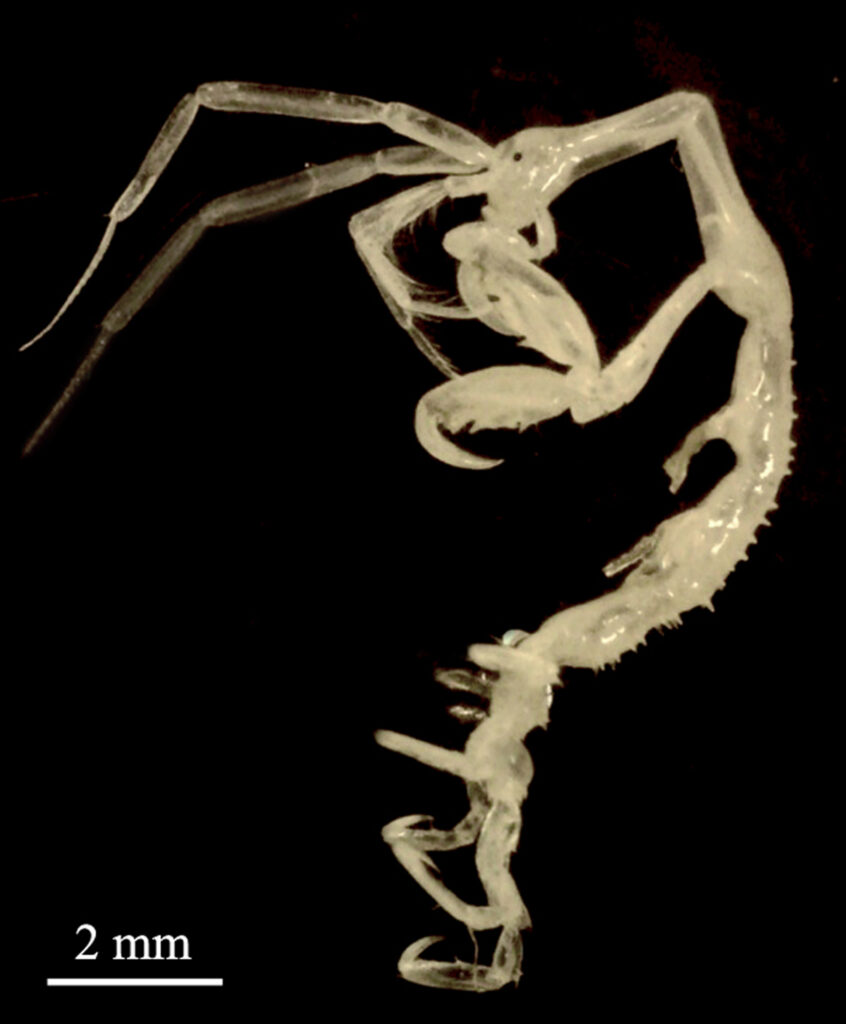
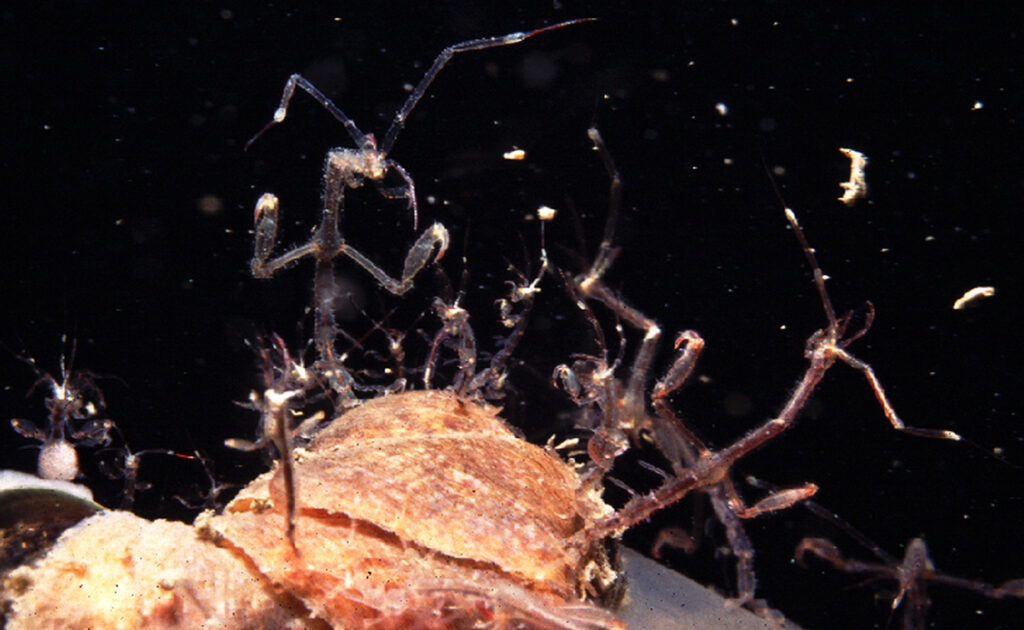
Japanese skeleton shrimp
Caprella mutica
Also known as: ghost shrimp
What does it look like?
The arms, legs, tentacles and body of this brown to dark red amphipod, are twig like. This shrimp can become 5 cm in length, and often occur in high densities.
Distinguishing features
Specimens of Caprella mutica can become much larger (up to 5 cm) than most of the other Caprella species (up to ~2 cm), and tend to occur in much higher densities than the native Caprella species in northwestern Europe. Looking more in detail, this species has various distinct spines on its back, but no spines on its head or neck. Also, quite apparent in live specimens is the bright red colour on the edge of the tentacles, which appears to be absent in most of the other Caprella species. To identify specimens with certainty the exact locations of the spines on the body, and the form of the claws and head must be examined.
Confusion with similar species
Several similar looking Caprella species can be found in Europe. They can be distinguished from Caprella mutica by the presence and position of the spines, and the form of the head and claws.
What is its origin?
Northwest Pacific
Habitat
Caprella mutica is mainly found (with sea-squirts and sponges) on fouled floating objects like pontoons in marinas, fish farm cages and rope mussel installations in both exposed and sheltered bays. It only survives in constantly submerged habitats. These ghost shrimps prefer salinities of more than 16 ppt and water temperatures of less than 30 °Celsius.
Presence in Ireland
Present on the island of Ireland
Behaviour and Spread
Water temperatures of about 13-14 °Celsius are necessary for reproduction. Caprella mutica population densities start to increase in spring, reaching a peak in summer. As this species does not have a planktonic larval stage, natural dispersal mainly occurs by “adult” individuals, which swim along with the currents. In addition, they are mainly spread throughout Europe within hull fouling communities. As ghost shrimp die relatively easily when taken out of the water, shellfish transports are probably not an important transport vector.
Potential nuisance for aquaculture
Although Caprella mutica specimens can be found in extremely high densities on for example rope mussels, they do not seem to compete with these mussels for food or cause any harm. High numbers of ghost shrimps do appear to attract fish to the mussel rope cultures as these fish feed on them.
Key Management Actions
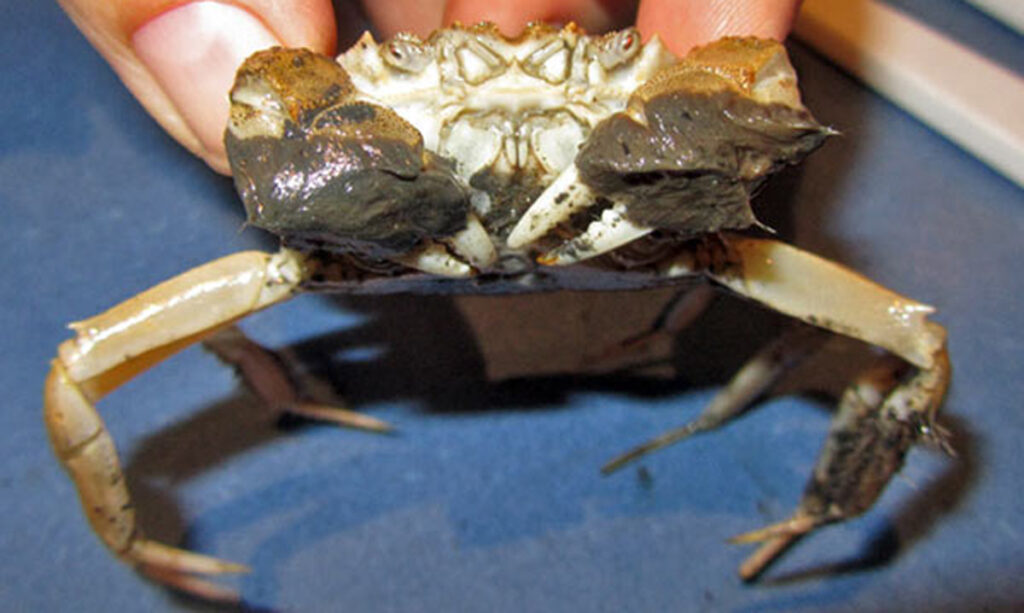
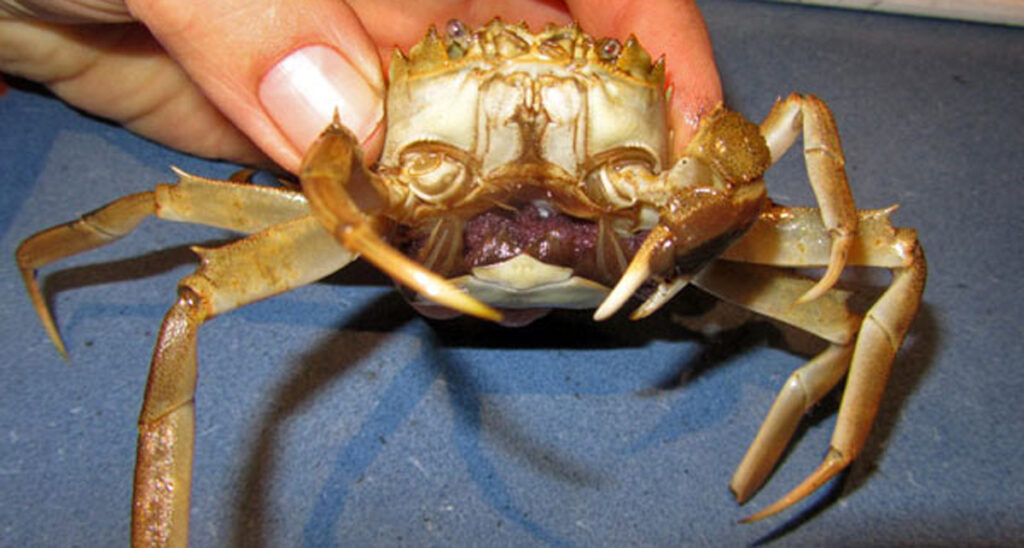
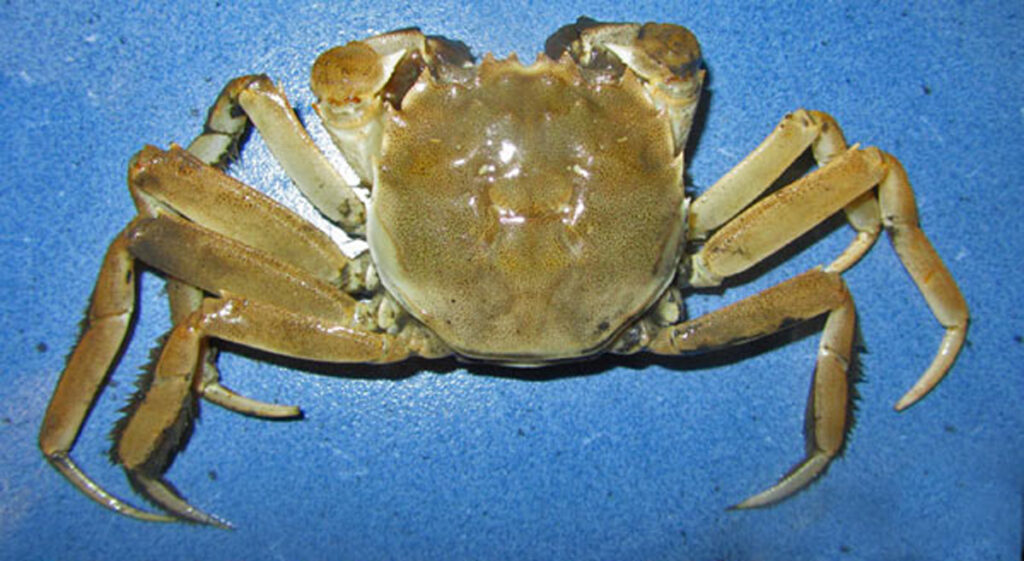
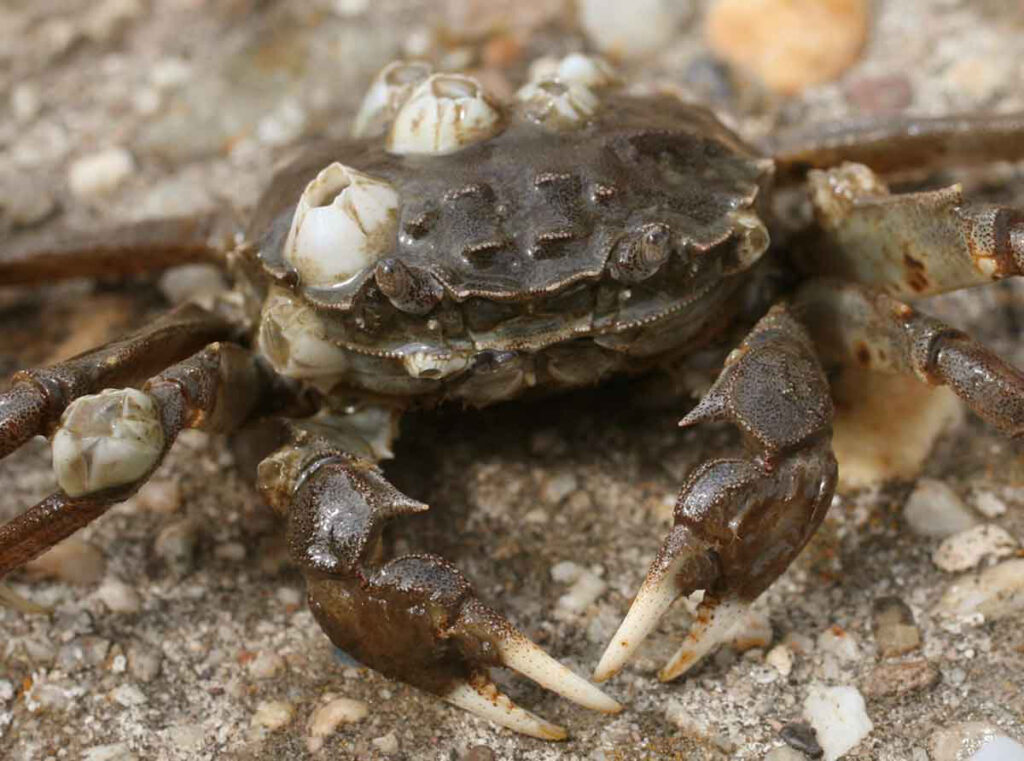
Eriocheir sinensis
Also known as: Chinese mitten crab
What does it look like?
Large juveniles and adults of the Chinese mitten crab have a dense mat of hair on their white-tipped claws. The brownish coloured crabs can have a carapace width of up to 8 cm.
Distinguishing features
The Chinese mitten crab has a carapace with four spines between the eyes. Older individuals have hairs all over their claes. Based on these two features it can be distinguished from all other crab species that are known to have established populations in western Europe. The pattern of dots and ridges on the back of the carapace and just underneath the eyes, can also be used as distinguishing features if (juvenile) crabs have not yet developed hairs on the claws.
Confusion with similar species
The only other crab species in north-western Europe that has hair on its claws, but not over the rest of its body is the Asian brush-clawed shore crab Hemigrapsus takanoi, but this species does not have any spines on the carapace between the eyes. In addition, H. takanoi specimens do not commonly have a carapace width of more than 2 cm.
What is its origin?
Northwest Pacific
Habitat
The Chinese mitten crab can be found throughout the year in freshwater, where it may live in between rocks or in tunnels that it creates in riverbanks and shorelines. For its reproduction it needs to return to the sea, where it is only found seasonally, usually during late summer, in estuaries.
Presence in Ireland
Present on the island of Ireland (Waterford Harbour). There have been reports in the Irish Sea along the British Coast.
Behaviour and Spread
In late summer males and females move from rivers and lakes downstream to tidal estuaries where they will attain sexual maturity. Depending on their size the females will produce between 250,000 and 1 million eggs, which they will carry with them until they hatch in spring, in brackish waters. Larval development then takes place in estuaries after which the juveniles gradually move upstream into freshwater habitats.
Potential nuisance for aquaculture
Chinese mitten crabs live in fresh water for most of their lifecycle. During reproduction in late summer, when they are found in estuaries, these voracious omnivores may feed on mussels. Fishers that use cages and nets can be impacted as the crabs are strong, potentially damaging the fishing gear if they are caught. Fishers removing them from nets must be careful as these crabs seem to be much more aggressive than most of the native crab species.
Key Management Actions
When transporting mussels from an area where Chinese mitten crabs have been recorded, take the breeding season of the crabs into account. For most of the year they will be in freshwater and during that period, it is unlikely that any crabs will be present among marine shellfish. Chinese mitten crabs can easily be caught in crab cages, and it is therefore possible to monitor for their presence in the estuaries (close to the river) during the breeding season which may vary between regions.
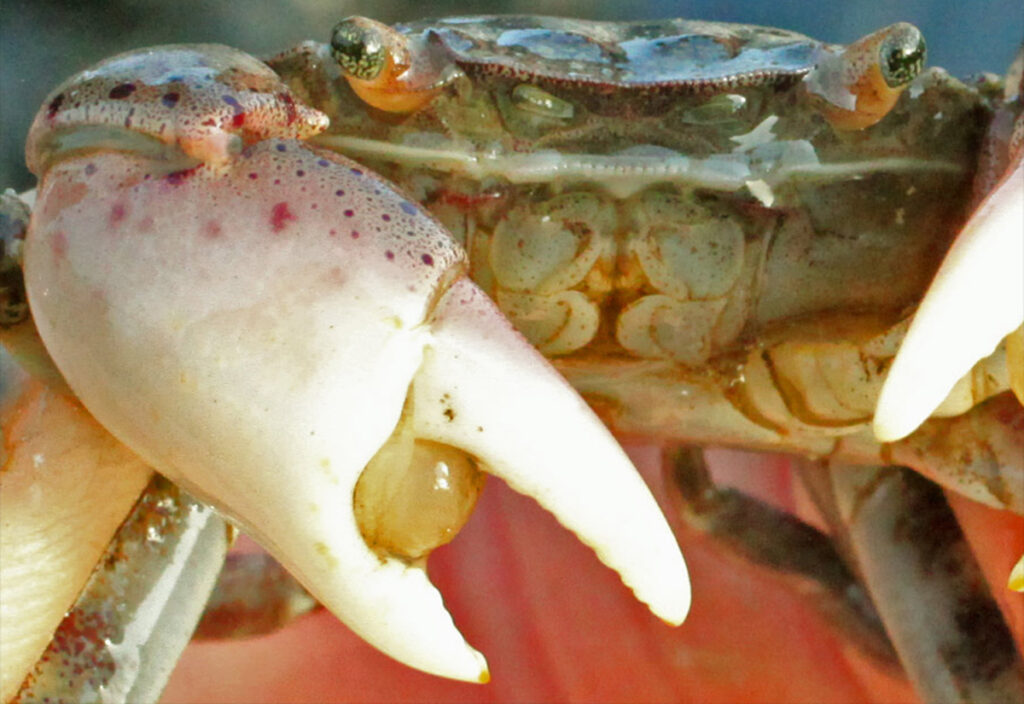
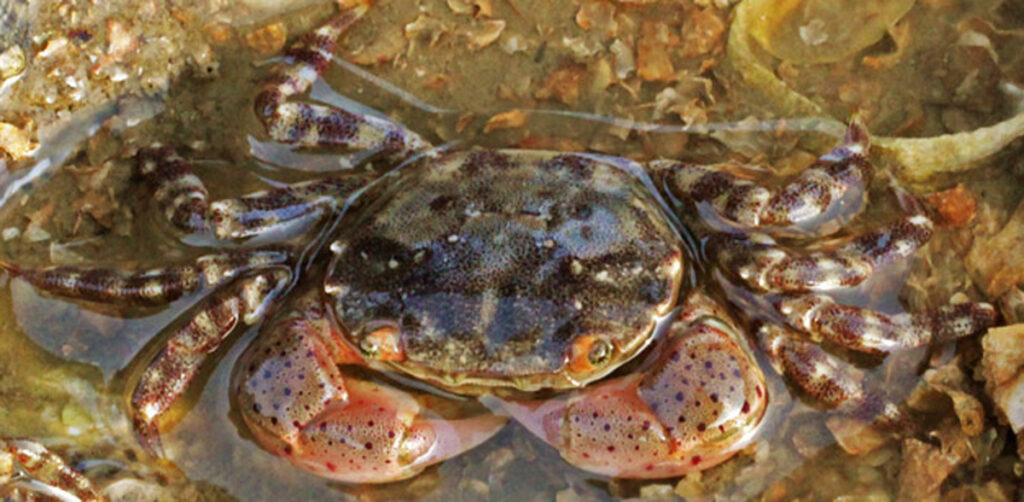
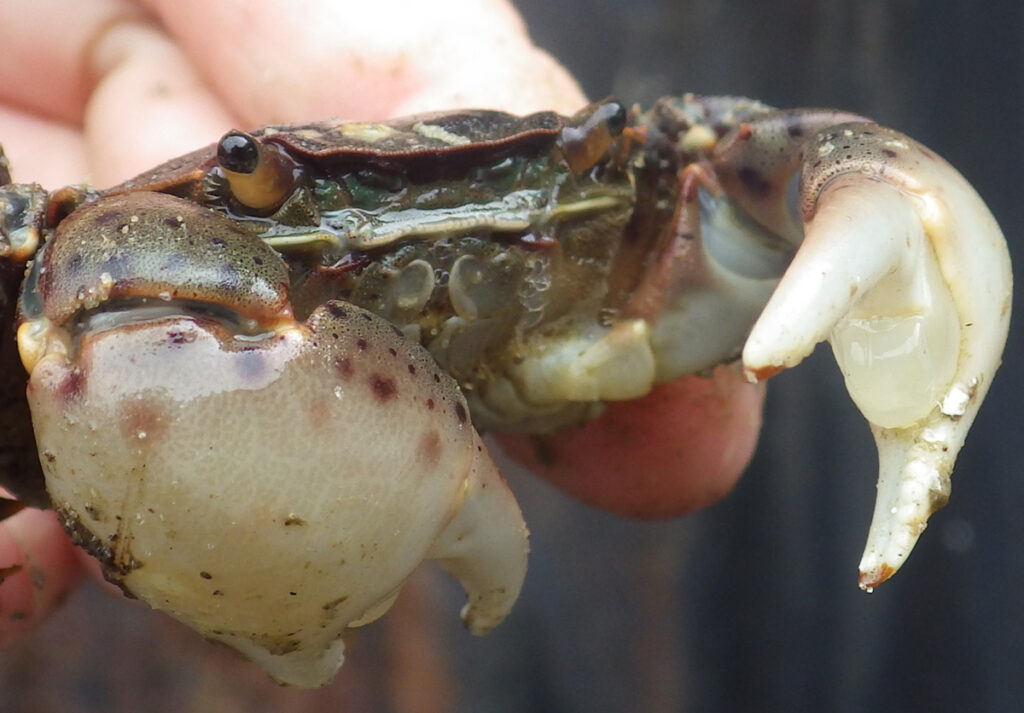
Asian shore crab
Hemigrapsus sanguineus
Also known as: n.a.
What does it look like?
A small crab with a square carapace which can be up to 4 cm in width. It is usually beautifully and brightly coloured, green, purple and red, with dark red dots on its claws. The males have balloon like bubbles on their claws.
Distinguishing features
The Asian shore crab has no spines between its eyes on its square carapace. This feature distinguishes it from most native crabs. A second distinguishing feature is the ridge below its eyes, which has a continuous form. The males have balloon like bubbles on their claws, which are unique to H. sanguineus.
Confusion with similar species
The Asian shore crab Hemigrapsus sanguineus closely resembles the brush-clawed shore crab Hemigrapsus takanoi. To distinguish between these species, one should look at the ridge just beneath the eyes. While this ridge is continuous in H. sanguineus, it is clearly disrupted/dotted in H. takanoi. Another distinguishing character is that H. sanguineus males have small balloon like bubbles on their claws whereas H. takanoi males have hairs on their claws.
What is its origin?
Northwest Pacific
Habitat
The Asian shore crab is found in the intertidal and shallow subtidal on relatively exposed coastlines with boulders and rocks underneath which they hide. They can also be found in high densities on rope mussel lines and on oyster reefs.
Presence in Ireland
Not yet recorded on the island of Ireland. Hemigrapsus sanguineus is rare in Great Britain but is abundant along the mainland coastlines of north-western Europe from France to Denmark.
Behaviour and Spread
Hemigrapsus sanguineus females can produce > 50,000 eggs, starting in spring, after which planktonic larvae can be dispersed with currents. Larval settlement takes place in late summer and fall. The most likely vectors for introduction to Ireland would be ballast water transports, hull fouling and shellfish transports from mainland Europe.
Potential nuisance for aquaculture
Hemigrapsus sanguineus are known to feed on mussel seed, locally causing significant mussel mortalities, for example along the Atlantic coast of North America. Despite it being widespread along the European coastline such impacts on mussel populations have not yet been recorded.
Key Management Actions
Do not import mussels or oysters from an area where Hemigrapsus sanguineus crabs are recorded. These crabs can easily survive dry transport together with shellfish.
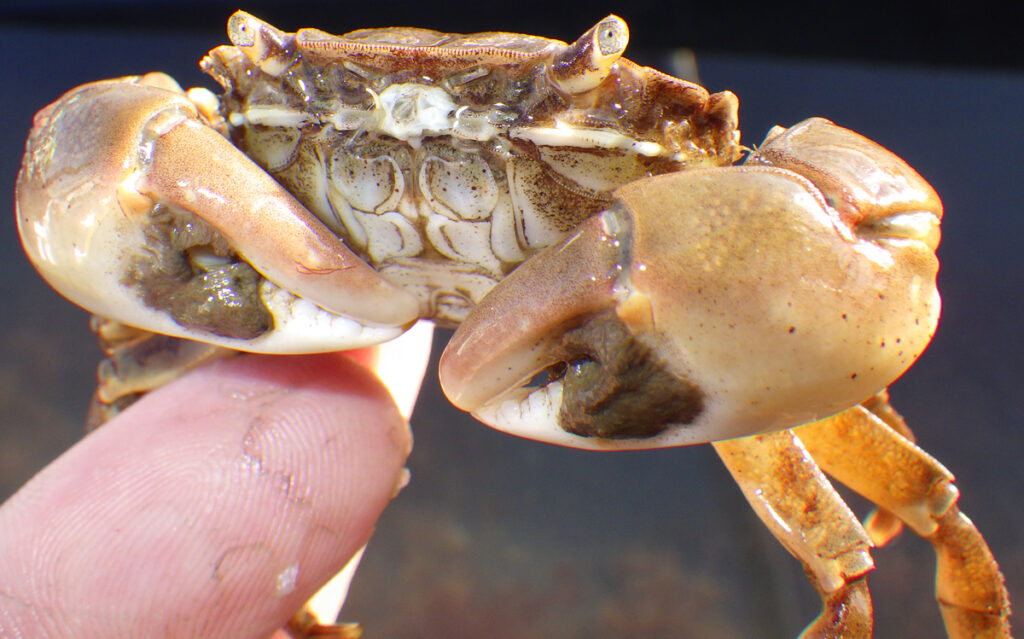
Brush-clawed shore crab
Hemigrapsus takanoi
Also known as: n/a
What does it look like?
A small crab growing to 4 cm with three teeth and spines on either side of a square shaped carapace. There are no spines between the eyes. It varies in colour from orange-brown to greenish-black and has banded/striped legs.
Distinguishing features
The brush-clawed shore crab has no spines between its eyes on its square carapace. This feature distinguishes it from most native crabs. A second distinguishing feature is the ridge below its eyes, which has a discontinuous, and at several places disrupted form. The males have hairs on their claws.
Confusion with similar species
The brush-clawed shore crab Hemigrapsus takanoi closely resembles the Asian shore crab Hemigrapsus sanguineus. To identify each species, one should look at the ridge just beneath the eye. While this ridge is continuous in H. sanguineus, it is clearly disrupted/dotted in H. takanoi. Another distinguishing character is that H. sanguineus males have small balloon like bubbles on their claws whereas H. takanoi males have hairs on their claws. Because of these hairs H. takanoi males are sometimes confused with Chinese mitten crabs (Eriocheir sinensis), which have similar hairy claws. Chinese mitten crabs have four spines in between their eyes, where H. takanoi specimens have no such spines in between the eyes.
What is its origin?
Northwest Pacific
Habitat
The brush-clawed shore crab is found in the intertidal and shallow subtidal on relatively sheltered coastlines and sites with boulders and rocks underneath which they hide. They can also be found in high densities on rope mussel lines and on oyster reefs.
Presence in Ireland
Not yet recorded on the island of Ireland. Hemigrapsus takanoi has rarely been sighted in Great Britain, but is abundant along the mainland coastlines of north-western Europe from France to Denmark.
Behaviour and Spread
Hemigrapsus takanoi breeds from spring to autumn, during which one female can produce 56,000 eggs. The planktonic larvae can be dispersed by currents for approximately one month until they become juvenile crabs. Several months later they reach maturity. The most likely vectors of introduction into Ireland would be ballast water transports, hull fouling and shellfish transports from mainland of Europe.
Potential nuisance for aquaculture
Hemigrapsus takanoi are known to feed on mussel seed, but it remains uncertain if an introduction to Ireland would result in significant mussel mortalities.
Key Management Actions
Do not import mussels or oysters from an area where Hemigrapsus takanoi crabs were recorded. These crabs can easily survive dry transport together with shellfish.